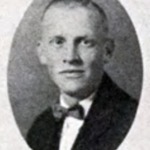Interviewer: Kim Smith
Interview Date: May 7, 1986
Location: The Memorial Union, Oregon State University
Duration: 0:55:29
This interview with Mark Astrup, the former director of the Oregon State Parks, begins with Astrup describing his interests in landscape architecture and how that led him to his enrollment at Oregon Agricultural College. He then traces his early career, beginning with his work for the Portland-based landscape construction firm Doty, Doerner and Doris, on through his time with the Civilian Conservation Corps, the United States Army, and the State Highway Commission.
Next, Astrup reflects on the relationship between the state parks and the State Highway Commission, and comments on his work as Assistant State Park Superintendent. He discusses his involvement with Deception Pass State Park as well as the development of roadside rest areas on Oregon’s interstate highways. From there, he shares his memories of several Oregon State Park Superintendents, including Samuel Boardman, Glen Jackson, and Chester Armstrong.
Astrup then recounts his tenure as Oregon State Parks Superintendent, mentioning his accomplishments while in office, including the publication of a book on state park development. He goes on to note his views on camping in state parks and discusses the purpose of interpretive centers. He concludes by offering final reflections on his long tenure of service to the state parks system.
Dublin Core
Title
Description
Next, Astrup reflects on the relationship between the state parks and the State Highway Commission, and comments on his work as Assistant State Park Superintendent. He discusses his involvement with Deception Pass State Park as well as the development of roadside rest areas on Oregon’s interstate highways. From there, he shares his memories of several Oregon State Park Superintendents, including Samuel Boardman, Glen Jackson, and Chester Armstrong.
Astrup then recounts his tenure as Oregon State Parks Superintendent, mentioning his accomplishments while in office, including the publication of a book on state park development. He goes on to note his views on camping in state parks and discusses the purpose of interpretive centers. He concludes by offering final reflections on his long tenure of service to the state parks system.

